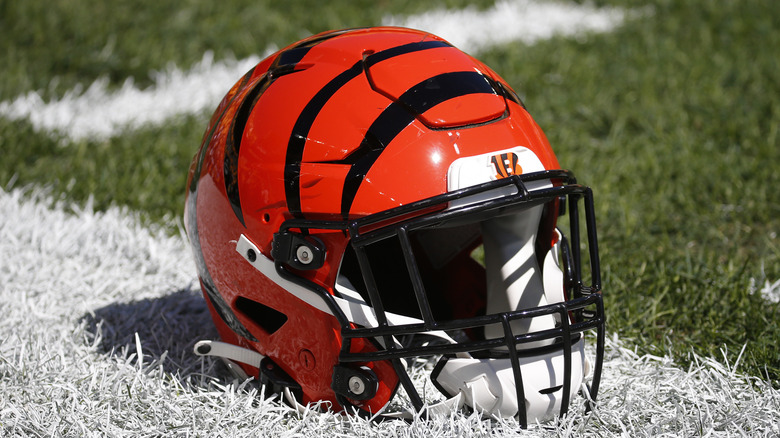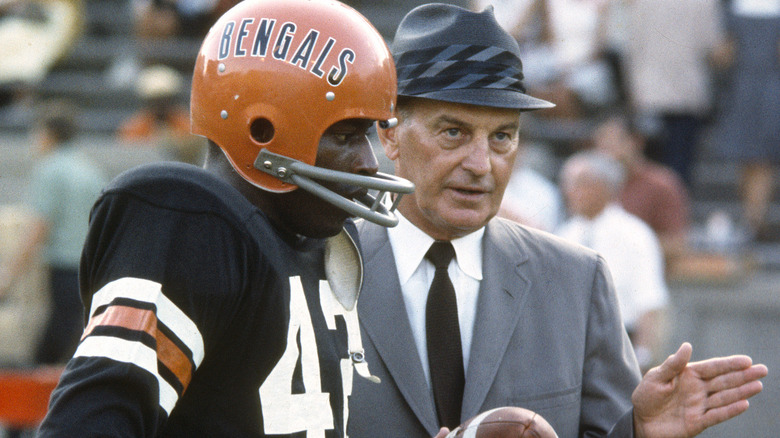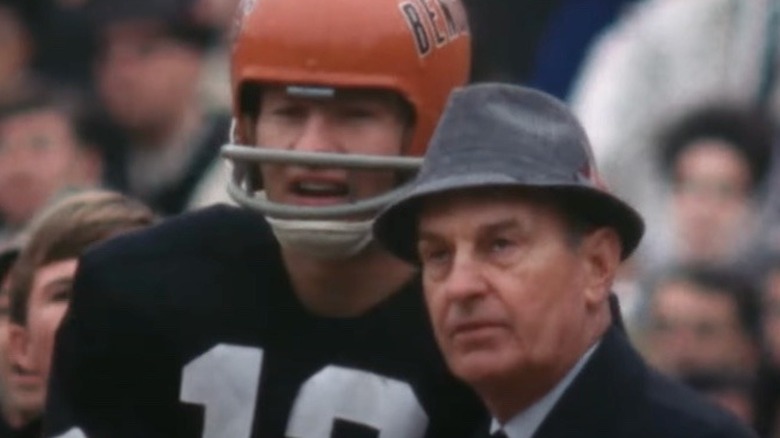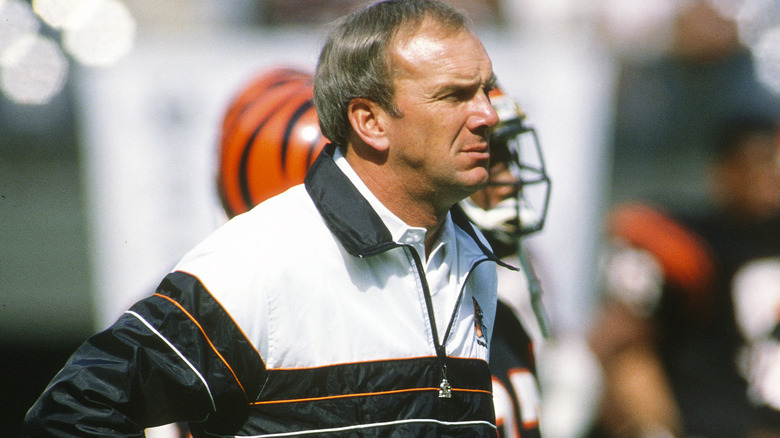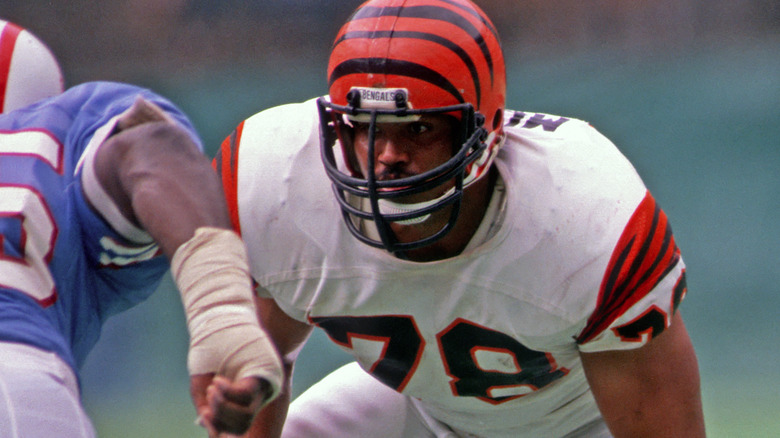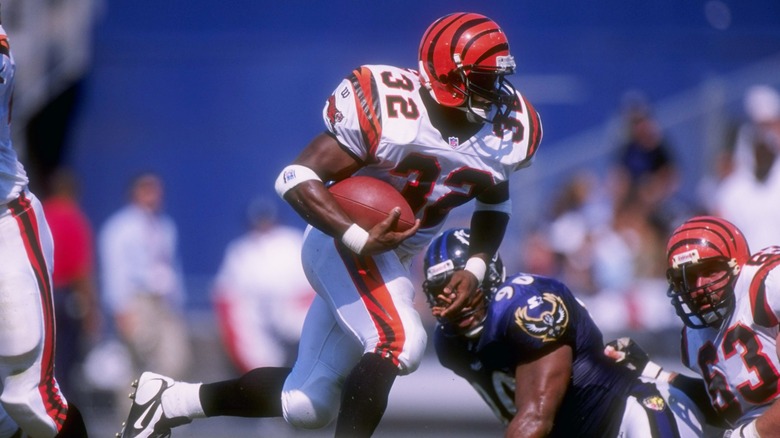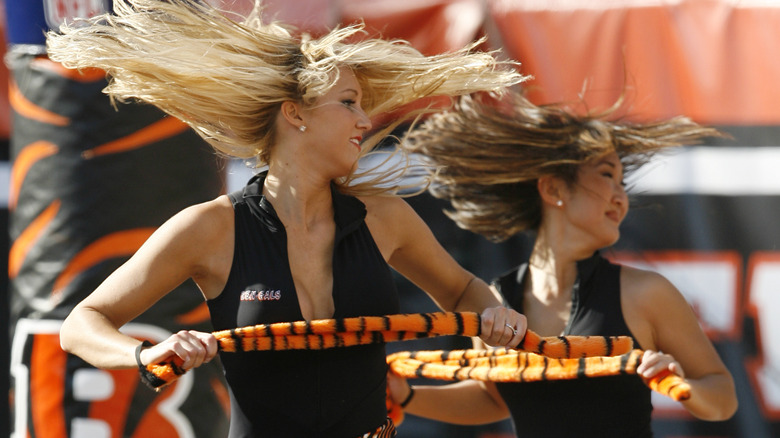The Untold Truth Of The Cincinnati Bengals
Though they've been around for more than five decades, the Cincinnati Bengals are among the NFL's newer organizations, and in terms of their all-time win-loss percentage, they currently sit at 26th out of 32 teams at .449. That's not exactly the most inspiring of statistics, but with young Joe Burrow behind center and justifying his first overall selection in the 2020 NFL Draft, there's a solid chance they'll be improving on that record in the years to come. As it is, Burrow helped take the Bengals to Super Bowl LVI, marking only their third Super Bowl appearance in franchise history, and also their first since Super Bowl XXIII in 1989. Needless to say, that's a pretty mean feat for a second-year quarterback.
In the years before Burrow arrived in Cincinnati, the Bengals had all sorts of ups and downs, from promising beginnings with a Hall of Fame coach-slash-owner to long playoff droughts. And while most fans may be familiar with Burrow's on-field heroics, linebacker Vontaze Burfict's reign of terror as one of the NFL's dirtiest players, or those Carson Palmer- and Andy Dalton-led playoff teams that never made it past the wild-card round, there are several lesser-known facts about the Cincinnati Bengals that need a deeper dive.
They were the AFL's final expansion team
Kicking off its first season in 1960, the American Football League (AFL) was a formidable competitor to the NFL for an entire decade before both leagues merged in 1970. The AFL, which operated with eight teams through 1965, added a ninth team in the Miami Dolphins in 1966, and in 1968, the Cincinnati Bengals became the league's 10th and final member — its second and last expansion team, in other words. As you'd expect from an expansion team, the 1968 Bengals weren't very good, finishing with a 3-11 record. But they had a certified legend as their head coach and owner, and that was Paul Brown, who had served as head coach and general manager of his namesake team, the Cleveland Browns, since their inaugural season in 1946 before a dispute with owner (and would-be NFL supervillain) Art Modell led to his dismissal in 1963 (via The Plain Dealer).
Despite his iconic status, Brown isn't that fondly remembered in Bengals lore ... or AFL lore, for that matter. According to Remember the AFL, he was infamously quoted as saying that he "didn't pay $10 million to be in the AFL," seemingly hinting that he thought little of the upstart league. But with the two pro football leagues' merger set in stone at the time Cincinnati joined the AFL, it would appear that Brown softened his stance, as he coached the Bengals for another seven seasons after their debut.
This hometown hero could have been the Bengals' first great QB
Many longtime Cincinnati Bengals fans will likely name Ken Anderson as the franchise's first great quarterback, and with good reason — he played his entire NFL career (1971-86) with the Bengals and made four Pro Bowls in his 16 seasons. But prior to the emergence of Anderson, the Bengals had a signal-caller who was poised to be one of the league's all-time greats. And he happened to be a hometown hero of sorts, an Ohio native who played college football for the University of Cincinnati.
As shown on his Pro Football Reference page, Greg Cook had a sensational rookie season for the Bengals in 1969 after getting picked No. 5 overall in that year's draft. While 15 touchdown passes, 11 interceptions, and an 88.3 QB rating aren't much to write home about by today's standards, the latter figure was good enough to lead the entire AFL, and his play earned him UPI's Offensive Rookie of the Year award (via Cincy Jungle). Sadly, he tore his rotator cuff just three weeks into his rookie season, and the injury went undiagnosed, with Cook only able to play as a result of cortisone shots he took to dull the pain. By the time he underwent shoulder surgery, it was too late — he was also found to have a partially detached bicep, and all that forced him to miss the next three seasons.
After his 1973 comeback attempt failed, Cook retired from football, having played just one full season. He died on January 27, 2012, at the age of 65.
The Bengals were offensive innovators
During their first few decades, the Cincinnati Bengals came up with a few notable innovations in football strategy, including two on the offensive side of the ball. These included the West Coast Offense, which was designed by future San Francisco 49ers head coach Bill Walsh. Hired by the Bengals as an assistant in 1968, Walsh came up with a playbook that was meant to maximize the expansion team's limited talent pool. This, for one, involved a focus on stretching the field horizontally, an ideal strategy that benefited the likes of Virgil Carter, a weak-armed quarterback who was nonetheless very accurate when throwing short passes (via Mile High Report). The West Coast Offense would later grow in popularity when Walsh joined the 49ers in 1979 and worked on developing a young, "noodle-armed" quarterback by the name of Joe Montana. You might have heard of him.
For most of the 1980s, Cincinnati was coached by Sam Wyche (pictured above), a former journeyman quarterback who played his first three NFL seasons for the Bengals. His contribution to pro football playmaking was the no-huddle offense, which, as its name suggests, involves taking just a few seconds of the play clock to prepare for the next play. This gave the Bengals a potent offense, one so potent that in January 1989, then-NFL commissioner Pete Rozelle allegedly threatened to issue unsportsmanlike conduct penalties to Cincy if they ran the no-huddle during their AFC Championship Game matchup against the Buffalo Bills (via ESPN). Nothing ever came of those threats, and the Bengals beat the Bills ... before losing to Walsh's 49ers at Super Bowl XXIII.
They've only had one Hall of Famer who played his entire career in Cincinnati
Most NFL franchises have multiple Hall of Famers who spent most, if not all of their career playing for that team. But what about the Cincinnati Bengals? Wide receiver Charlie Joiner played a whopping 18 seasons in the pros, but only three and a half of them were spent in Cincinnati. Terrell Owens, meanwhile, was a 15-year veteran when he retired in 2010, but his time in Cincy was limited to his final professional season — a pretty good one statistically, but a far cry from vintage T.O. That leaves offensive tackle Anthony Munoz as the only Pro Football Hall of Famer who can be unarguably linked to the Bengals. And why would he be linked to other teams — the man's entire 13-year NFL career was spent with the Bengals (save for an aborted comeback in 1993 with the Tampa Bay Buccaneers), and all he did was get named to nine All-Pro teams and play in 11 Pro Bowls.
Munoz was selected third overall in the 1980 NFL Draft after a stellar career at USC, and as Britannica noted, he was initially considered a risky pick due to a history of knee injuries. But he turned out to be a star from day one, combining impressive size for the time (he stood 6-feet-6-inches and weighed 280 pounds) with quickness and athleticism as he became one of the NFL's greatest left tackles ever.
Draft busts aplenty in the '90s and early '00s
After losing at Super Bowl XXIII, the Cincinnati Bengals remained solid for a couple more seasons before the wheels totally fell off in 1991, which would be the first of 14 seasons in which they would fail to make the playoffs. Much of this had to do with their sheer inability to rebuild through the draft.
To be fair, the Bengals had their share of draft busts before the 1990s — Jack Thompson and two-time Heisman Trophy winner Archie Griffin immediately come to mind. But as Cincy Jungle documented, the '90s were a brutal decade for Cincinnati in the NFL Draft. Quarterbacks David Klingler (No. 6, 1992) and Akili Smith (No. 3, 1999) only lasted a few seasons with the Bengals and produced pedestrian numbers behind center. Running back Ki-Jana Carter (No. 1, 1995, pictured above) showed flashes of brilliance, but injuries prematurely ended what could have been a great career. And while defensive tackle Dan "Big Daddy" Wilkinson (No. 1, 1994) had a solid career, as noted by The Sports Daily, he didn't quite live up to the expectations of a first overall pick. Then you've got the Bengals' busts from the early 2000s, a list that most notably includes wide receiver Peter Warrick (No. 4, 2000).
With all that said, the Bengals are very fortunate that Joe Burrow has lived up to his draft billing so far, unlike all the other names we mentioned above.
They had the oldest cheerleader in NFL history
Typically, NFL cheerleaders are young women in their early-to-mid-20s. Sometimes, they can be a bit younger or older, but in the case of Laura Vikmanis, she was a 40-year-old divorced mom of two when she successfully tried out for the Cincinnati Ben-Gals — the Bengals' cheerleading squad — in 2009. That made her the oldest cheerleader in NFL history, and she ended up spending a total of six seasons with the squad. She also co-wrote a book with Amy Sohn that documented her unlikely journey to the Ben-Gals, and as of 2011, there was talk of a possible biopic, according to a report from Cincinnati.com.
Unfortunately, Vikmanis' time with the Ben-Gals didn't come without its challenges. In an op-ed she and Sohn co-wrote for The New York Times in 2018, the former cheerleader stressed that she never felt discriminated against because of her age. However, she made several allegations of "gender-based discrimination" against the Bengals, including, but not limited to the draconian rules the squad supposedly had to follow and the "extraordinarily low pay" they received. "Even when the rules were reasonable, there was sexist thinking and language throughout," Vikmanis wrote.
It should also be noted that the issues Vikmanis pointed out weren't exclusive to the Bengals, as two other ex-cheerleaders, Kristan Ware (Miami Dolphins) and Bailey Davis (New Orleans Saints), sued the NFL for gender discrimination shortly before the New York Times op-ed was published.
